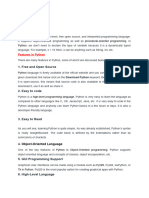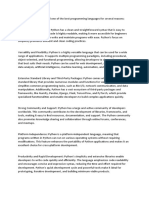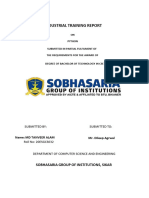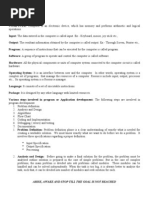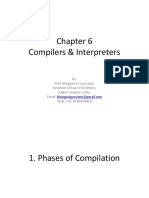Python
Uploaded by
Zumra AjeethPython
Uploaded by
Zumra AjeethPython is a high-level, interpreted programming language known for its simplicity,
readability, and versatility. It was created in the late 1980s by Guido van Rossum and was
first released in 1991. Python has gained immense popularity over the years and has
become one of the most widely used programming languages. Here are some key
characteristics and uses of Python:
1. Readability: Python's syntax is designed to be easy to read and write. It emphasizes
clean and concise code, which makes it an excellent choice for both beginners and
experienced programmers.
2. Interpreted Language: Python is an interpreted language, which means that code is
executed line by line by the Python interpreter. This allows for quick development
and testing, as there's no need for a separate compilation step.
3. Cross-Platform: Python is available on various operating systems, including
Windows, macOS, and Linux. Code written in Python can run on different platforms
without modification.
4. Extensive Standard Library: Python comes with a comprehensive standard library
that provides modules and functions for a wide range of tasks, from file handling and
regular expressions to networking and web development. This library reduces the
need to write code from scratch for many common tasks.
5. Open Source: Python is open-source software, meaning it's freely available, and its
source code can be viewed, modified, and distributed by anyone. This has
contributed to its widespread adoption and continuous improvement.
6. Dynamic Typing: Python uses dynamic typing, which means that variable types are
determined at runtime, making it flexible and accommodating for various data types.
7. High-Level Language: Python abstracts many low-level details, which allows
developers to focus on solving problems rather than dealing with complex system
operations.
8. Community and Ecosystem: Python has a large and active community of developers.
This has led to the creation of a vast ecosystem of libraries and frameworks for
various purposes, including web development (Django, Flask), scientific computing
(NumPy, SciPy), data analysis (Pandas), machine learning (TensorFlow, PyTorch), and
more.
9. Versatility: Python is used in a wide range of applications, including web
development, scientific research, data analysis, artificial intelligence, automation,
scripting, game development, and more. Its versatility makes it a valuable tool in
many domains.
10. Popular in Education: Python is often used as a first programming language in
education due to its simplicity and readability. It's also a preferred language for
teaching computer science and programming concepts.
Python's popularity continues to grow, and it is widely regarded as one of the most
important programming languages for a variety of tasks. Its ease of use, extensive
ecosystem, and community support have made it a go-to choice for many developers and
organizations.
You might also like
- Vdoc - Pub - Build Your Own Net Language and Compiler100% (1)Vdoc - Pub - Build Your Own Net Language and Compiler399 pages
- The forest was alive with the sound of rustling leaves and the occasional snap of a twig underfootNo ratings yetThe forest was alive with the sound of rustling leaves and the occasional snap of a twig underfoot3 pages
- Module 1 Introduction To Python - AssignmentNo ratings yetModule 1 Introduction To Python - Assignment6 pages
- Practical Guide to Python: From Basics to Advanced ProgrammingFrom EverandPractical Guide to Python: From Basics to Advanced ProgrammingNo ratings yet
- Essential Guide To Python For All Levels (2024 CollectionNo ratings yetEssential Guide To Python For All Levels (2024 Collection184 pages
- Python_ Advantages, Diversification, and Future-Proofing - Google DocsNo ratings yetPython_ Advantages, Diversification, and Future-Proofing - Google Docs45 pages
- Chapter 1 - Introduction To Computers, The Internet, and The WebNo ratings yetChapter 1 - Introduction To Computers, The Internet, and The Web26 pages
- Experiment No. 1: Prolog-Programming in LogicNo ratings yetExperiment No. 1: Prolog-Programming in Logic3 pages
- Cs - Project - New Project On Mahesh HouseNo ratings yetCs - Project - New Project On Mahesh House24 pages
- Evolution of The WAM:: Introduction To Prolog Implementation: The Warren Abstract Machine (WAM)No ratings yetEvolution of The WAM:: Introduction To Prolog Implementation: The Warren Abstract Machine (WAM)21 pages
- A Project Report On Bank Management System in Python - 20231215 - 073348 - 0000No ratings yetA Project Report On Bank Management System in Python - 20231215 - 073348 - 00007 pages
- 5-6-Compiler Structure, Phases and Passes, BootstrappingNo ratings yet5-6-Compiler Structure, Phases and Passes, Bootstrapping50 pages
- farrell23936_1111823936_02_01_chapter01No ratings yetfarrell23936_1111823936_02_01_chapter0142 pages
- Chapter # 1: Introduction To Computer: Govt. Jamia Qasim-Ul-Uloom H/S SargodhaNo ratings yetChapter # 1: Introduction To Computer: Govt. Jamia Qasim-Ul-Uloom H/S Sargodha5 pages
















































